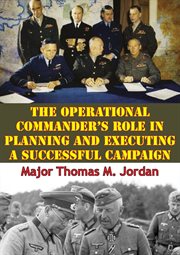Nonfiction
eBook
Details
PUBLISHED
DESCRIPTION
1 online resource
ISBN/ISSN
LANGUAGE
NOTES
The rise of industrialization coupled with the growth of technology have contributed to creating a complexity to modern warfare that far exceeds the primitive conditions of earlier periods. Defined as the creative use of distributed operations for the purposes of strategy, success at the operational level requires that commanders practice operational art. Although current doctrine recognizes that the operational commander must link theater strategy to tactical operations through operational art, it fails to provide an adequate description of the commander role in campaign planning. Thus, this monograph examines the operational commander's role in planning and executing a successful campaign. The monograph begins by describing how industrialized societies and technology affected the evolution of warfare thus creating a new medium known as operational art. Next it discusses suitable criteria for determining the commander's role in operational campaigns followed by an explanation of the campaign analysis model consisting of the operational operating systems described in TRADOC Pam 11-9. The monograph then analyzes three successful campaigns: Field-Marshal Slim as the 14th Army commander in Burma; General MacArthur in the World War II Cartwheel Operation and General Ridgway as the 8th Army commander in Korea
Mode of access: World Wide Web







